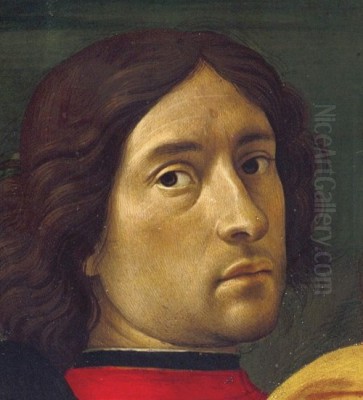
Domenico Ghirlandaio (1449–1494) stands as one of the most significant and prolific painters of the Florentine Quattrocento, the vibrant period of the early Italian Renaissance. His life and career unfolded primarily in Florence, the era's undisputed artistic crucible. Renowned for his large-scale fresco cycles, insightful portraits, and the meticulous detail embedded in his work, Ghirlandaio captured the spirit of his age, blending sacred narratives with vivid depictions of contemporary Florentine life and its prominent citizens. His workshop was among the most active in the city, and his influence extended to the next generation, most notably through his brief tutelage of the young Michelangelo.
Early Life and Artistic Formation
Domenico di Tommaso di Currado di Doffo Bigordi was born in Florence in 1449. His father, Tommaso Bigordi, was a goldsmith, a highly respected craft that often served as a training ground for aspiring painters due to its emphasis on precision, design, and metalworking techniques. It is from his father's trade that Domenico likely derived his famous nickname, "Ghirlandaio," meaning "garland-maker." Giorgio Vasari, the renowned Renaissance biographer, recounts that Tommaso was celebrated for crafting fashionable metallic garlands worn by Florentine women, a name that subsequently attached itself to his talented son.
This initial exposure to the goldsmith's craft undoubtedly instilled in the young Domenico an appreciation for fine detail and meticulous execution, qualities that would become hallmarks of his mature painting style. While he learned the rudiments of design in his father's shop, his true calling lay in painting. His formal artistic training commenced under the guidance of Alesso Baldovinetti, a respected Florentine master known for his work in painting, mosaic, and stained glass.
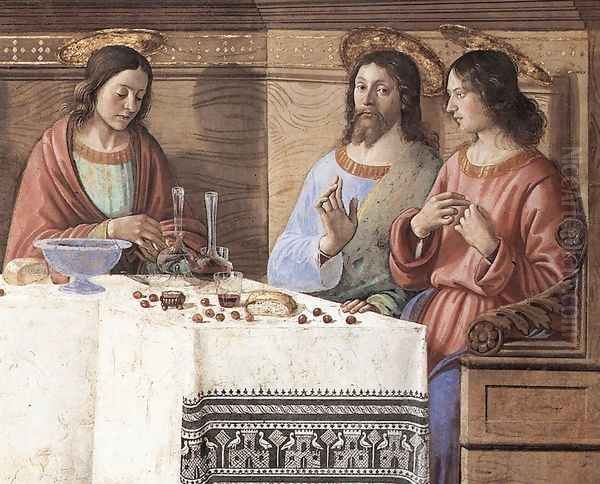
Baldovinetti's instruction would have provided Ghirlandaio with a solid foundation in the techniques of the time, particularly fresco painting and the principles of composition and perspective that were central to Florentine art. Some accounts, including Vasari's, suggest a possible, though less certain, connection or period of study with Andrea del Verrocchio, another towering figure in Florentine art whose workshop famously trained Leonardo da Vinci and Sandro Botticelli. While direct evidence remains debated, Ghirlandaio certainly moved within the same artistic circles and absorbed the prevailing currents of naturalism and technical proficiency.
The Bustling Ghirlandaio Workshop
A crucial element of Ghirlandaio's success was his exceptionally well-organized and productive workshop. In an era when large-scale commissions, especially frescoes, required significant manpower, an efficient studio was essential. Ghirlandaio operated his workshop as a family enterprise, collaborating closely with his brothers, Davide Ghirlandaio and Benedetto Ghirlandaio, who were capable painters in their own right. His brother-in-law, Sebastiano Mainardi from San Gimignano, also became a key member of the workshop team.
This collaborative structure allowed Ghirlandaio to undertake numerous ambitious projects simultaneously and complete them with remarkable speed and consistency. Davide, in particular, seems to have played a significant role in managing the workshop's business affairs and assisting with the execution of paintings. While Domenico remained the undisputed master and creative force, the contributions of his family members were integral to the workshop's output and reputation. The Ghirlandaio style, characterized by clarity, detailed realism, and compositional stability, became a recognizable brand, sought after by patrons throughout Florence and beyond. The workshop tradition would be continued after Domenico's death by his son, Ridolfo Ghirlandaio.
Establishing a Reputation: Early Commissions
Ghirlandaio quickly established his reputation with commissions in Florence and nearby towns. An early significant project took him to the Tuscan town of San Gimignano. There, in the Collegiata's Chapel of Santa Fina, he painted frescoes depicting scenes from the life of the local saint (c. 1475). These early works already demonstrate his burgeoning skill in narrative composition and his ability to render figures and architectural settings with convincing realism.
Back in Florence, Ghirlandaio received commissions for the Ognissanti church, a site associated with the prominent Vespucci family (whose members included the explorer Amerigo Vespucci). Around 1472, he painted the Madonna della Misericordia in the Vespucci chapel, protectively sheltering members of the family under her cloak. This work exemplifies the common practice of donor portraiture, integrating patrons directly into sacred scenes.
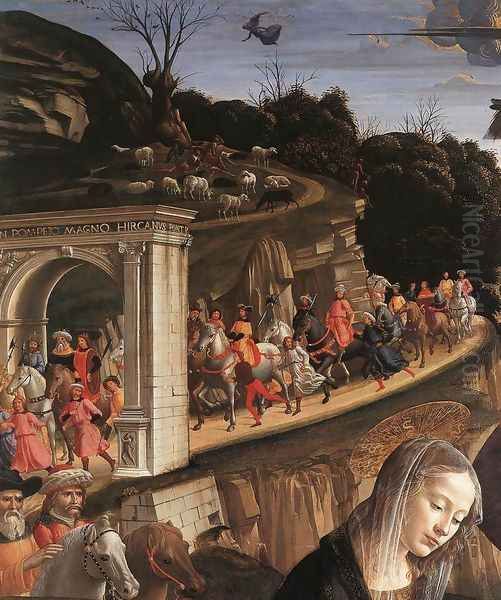
Also in Ognissanti, around 1480, Ghirlandaio painted a powerful Saint Jerome in His Study and a compelling Last Supper in the monastery's refectory. The Saint Jerome is often compared to a contemporary version of the same subject by Sandro Botticelli, also painted for Ognissanti. Ghirlandaio's interpretation emphasizes the scholar-saint's intellectual intensity and the tangible reality of his study, filled with meticulously rendered objects. His Last Supper established a compositional model he would revisit, depicting the apostles in a moment of quiet solemnity and psychological introspection, set within a clearly defined architectural space.
The Call to Rome: The Sistine Chapel
Ghirlandaio's growing fame led to one of the most prestigious commissions of the era: the decoration of the walls of the Sistine Chapel in the Vatican, Rome. In 1481-1482, Pope Sixtus IV summoned a team of the leading painters from Florence and Umbria to execute fresco cycles depicting scenes from the lives of Moses and Christ. Ghirlandaio worked alongside other luminaries such as Sandro Botticelli, Pietro Perugino, and Cosimo Rosselli.
Ghirlandaio's primary contribution to this grand project was the Calling of the Apostles Peter and Andrew. This fresco demonstrates his ability to handle complex multi-figure compositions and integrate numerous portraits into a biblical narrative. The scene unfolds against a wide landscape backdrop, with Christ calling the first apostles by the Sea of Galilee. Significantly, the foreground is populated by a crowd of contemporary witnesses, likely including members of the Florentine community residing in Rome. This practice of incorporating contemporary figures into sacred history was a signature element of Ghirlandaio's style, grounding the divine narrative in the observable world of his patrons. His work in the Sistine Chapel solidified his reputation as one of Italy's foremost masters.
Florentine Fresco Masterpieces: Sassetti and Tornabuoni Chapels
Upon his return from Rome, Ghirlandaio embarked on the two fresco projects that represent the pinnacle of his achievement and cemented his legacy in Florence: the Sassetti Chapel in Santa Trinita and the Tornabuoni Chapel in Santa Maria Novella.
The Sassetti Chapel (Santa Trinita)
Commissioned by Francesco Sassetti, a wealthy banker and prominent manager of the Medici bank, the Sassetti Chapel project (c. 1482–1485) involved decorating the chapel walls with scenes from the life of St. Francis of Assisi, the patron saint of Francesco. Ghirlandaio executed this cycle with characteristic narrative clarity and a wealth of observed detail.
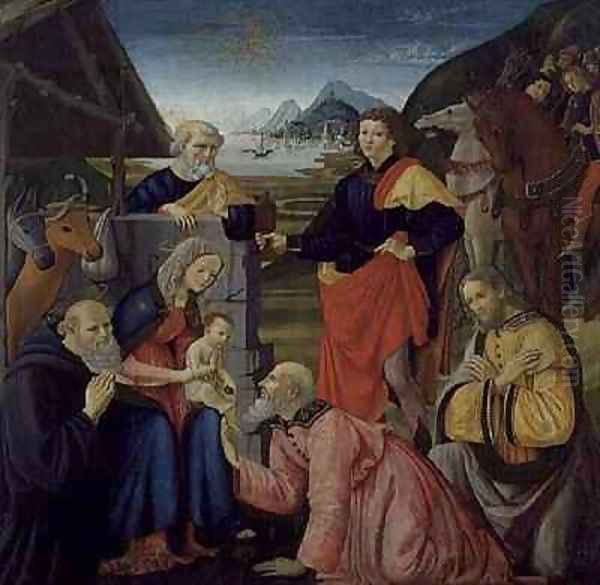
The frescoes transport the medieval story of St. Francis into contemporary Florence. In the scene Confirmation of the Franciscan Rule, the event is depicted not in Rome, but in Florence's Piazza della Signoria, with the Loggia dei Lanzi clearly visible. Francesco Sassetti himself appears, along with his sons and associates, including Lorenzo de' Medici ("the Magnificent"), Florence's de facto ruler. This deliberate anachronism served to link the patron and his powerful connections to the sanctity of the scene, celebrating both piety and civic pride.
The altarpiece for the chapel is the magnificent Adoration of the Shepherds (1485). This panel painting is particularly notable for its overt engagement with Northern European art, specifically the realism and detailed textures associated with Flemish painters. The recent arrival in Florence of Hugo van der Goes's Portinari Altarpiece had made a significant impact, and Ghirlandaio absorbed its lessons. His shepherds are depicted with rustic realism, and the painting includes classical elements like a Roman sarcophagus and triumphal arch, symbolizing the transition from the pagan world to the Christian era. The Sassetti Chapel cycle stands as a cohesive statement of faith, family honor, and Florentine identity.
The Tornabuoni Chapel (Santa Maria Novella)
Ghirlandaio's largest and most complex undertaking was the decoration of the vast choir chapel (the Cappella Maggiore) of Santa Maria Novella, commissioned by Giovanni Tornabuoni (c. 1485–1490). Tornabuoni, another influential figure connected to the Medici circle (he was Lorenzo de' Medici's uncle), desired a decorative scheme that would rival any other in Florence for its scale and splendor. Ghirlandaio and his workshop delivered spectacularly.
The frescoes cover the chapel's enormous walls with two parallel cycles: the Life of the Virgin Mary on one side and the Life of St. John the Baptist (Florence's patron saint) on the other. These narratives unfold across multiple registers, filled with dynamic compositions, elaborate architectural settings, and an astonishing array of contemporary portraits. The Tornabuoni Chapel frescoes function as a veritable "who's who" of late 15th-century Florentine society.
Scenes like the Birth of the Virgin and the Visitation are set within opulent Florentine interiors, showcasing the luxurious tastes and fashions of the city's elite. In the Visitation, Giovanna degli Albizzi (who married into the Tornabuoni family) appears prominently, depicted with elegant grace. The Annunciation to Zacharias is staged within a grand classical setting, populated by numerous members of the Tornabuoni family and other notable Florentine humanists and intellectuals, including Marsilio Ficino and Cristoforo Landino.
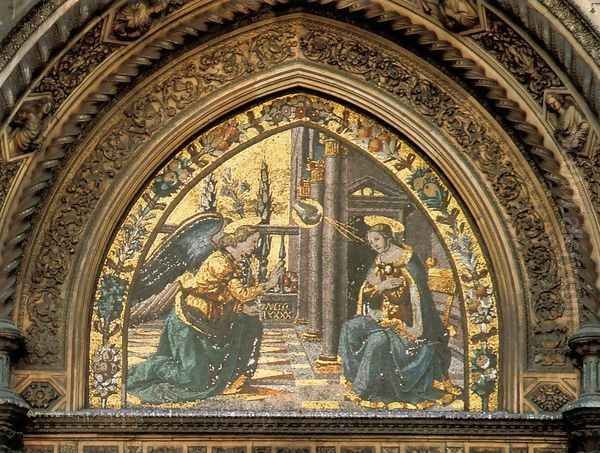
While celebrating the patrons and their social milieu, Ghirlandaio never loses sight of the narrative's clarity. His compositions are well-ordered, his figures solid and expressive, and his use of color bright and appealing. The Tornabuoni Chapel remains one of the most comprehensive visual documents of Florentine life during the Laurentian age, a testament to Ghirlandaio's skill as both a religious storyteller and a social chronicler.
A Gifted Portraitist
Beyond integrating portraits into his frescoes, Ghirlandaio was also a highly accomplished portrait painter in his own right. His portraits are characterized by their directness, psychological insight, and meticulous attention to detail in rendering likeness, costume, and setting.
Perhaps his most famous and moving portrait is An Old Man and His Grandson (c. 1490, now in the Louvre). This tender image depicts an elderly man with rhinophyma (a condition causing a disfigured nose) gazing lovingly at a young boy, presumably his grandson, who returns the look with innocent affection. Ghirlandaio does not shy away from the old man's physical imperfection but renders it with objective honesty, focusing instead on the emotional connection between the two figures. The landscape visible through the window adds depth and context. It is a work of profound humanity and psychological depth.
Another celebrated work is the Portrait of Giovanna Tornabuoni (1488, now Museo Thyssen-Bornemisza, Madrid). Painted posthumously after Giovanna's early death in childbirth, it presents her in elegant profile, adhering to a Quattrocento convention but imbued with Ghirlandaio's characteristic precision. She is depicted in luxurious attire, surrounded by symbolic objects within a niche setting. An inscription on a cartellino quotes the Roman poet Martial, praising her beauty and virtue, underscoring the portrait's commemorative function and idealized representation of female grace and status within Florentine society. These portraits showcase Ghirlandaio's ability to capture not just physical likeness but also aspects of character and social standing.
Panel Paintings and Other Media
While best known for his frescoes, Ghirlandaio was also proficient in panel painting, typically using tempera. His Adoration of the Magi (1487), painted for the Ospedale degli Innocenti (Foundling Hospital) in Florence, is a complex and crowded composition filled with figures, animals, and architectural details, showcasing his narrative flair on a smaller scale. He produced numerous altarpieces and devotional panels throughout his career, often assisted by his workshop.
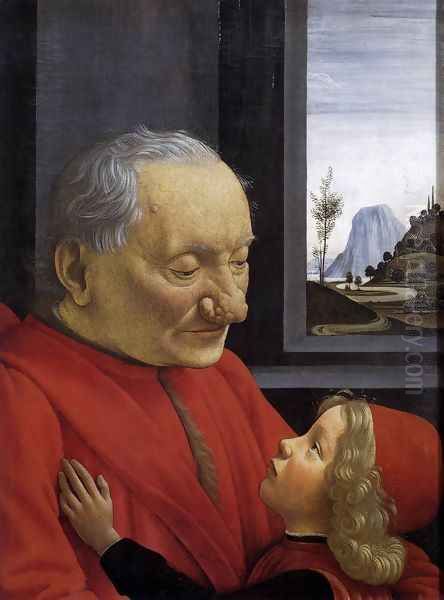
His training under Baldovinetti also equipped him with skills in mosaic, although fewer examples of his work in this medium survive. He reportedly created a mosaic of the Annunciation over one of the doors of Florence Cathedral. His versatility across different media underscores the comprehensive nature of his artistic training and the capabilities of his workshop.
Artistic Style, Influences, and Context
Ghirlandaio's style is characterized by clarity, solidity, and a strong narrative impulse. His compositions are typically well-balanced and legible, even when filled with numerous figures and details. He employed perspective effectively to create convincing spatial depth in his architectural settings. His figures are robust and possess a tangible physical presence, distinct from the more ethereal linearity of his contemporary, Botticelli. His color palette is generally bright and varied, contributing to the overall sense of vitality in his works.
His primary influence was the Florentine tradition stemming from Giotto and Masaccio, emphasizing naturalism, human drama, and rational spatial construction. He clearly learned from masters like Andrea del Castagno in terms of figural strength and from Fra Angelico in clarity of light and color. As noted, he was also receptive to the detailed realism of Netherlandish painting, particularly the work of Hugo van der Goes, which he skillfully integrated into his own idiom without sacrificing Florentine principles of design and monumentality. The influence of classical antiquity is also evident, particularly in the architectural motifs and decorative elements that frequently appear in his frescoes.
Ghirlandaio operated during the height of Florence's cultural flourishing under Lorenzo de' Medici. His patrons were among the city's wealthiest and most influential families, such as the Sassetti and Tornabuoni, who were closely allied with the Medici. His art reflects the confidence, prosperity, and civic pride of this era. He provided his patrons with works that were both pious and worldly, celebrating religious themes while simultaneously documenting their own status and the beauty of their city. He worked alongside and sometimes in competition with other leading artists like Botticelli, Perugino, Filippino Lippi, and the Pollaiuolo brothers (Antonio and Piero). His solid, descriptive style offered a popular alternative to the more poetic or scientifically experimental approaches of artists like Botticelli or Leonardo da Vinci.
Legacy and Enduring Influence
Domenico Ghirlandaio died relatively young in 1494, possibly from plague, cutting short a highly successful career. His immediate legacy was carried on by his workshop, including his brothers, brother-in-law, and his son Ridolfo Ghirlandaio, who became a respected painter in the High Renaissance style.
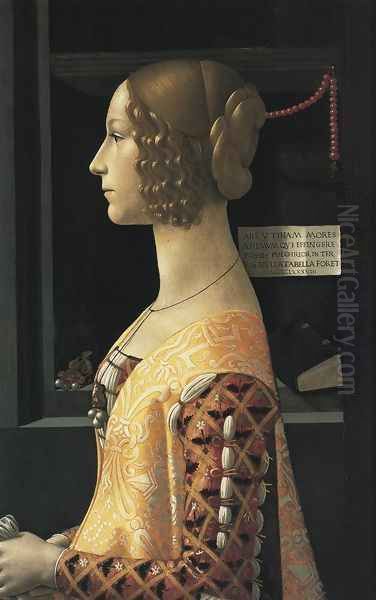
His most famous pupil was Michelangelo Buonarroti, who, according to contracts and early biographies, entered Ghirlandaio's workshop as an apprentice around 1488 at the age of 13. Although Michelangelo later downplayed Ghirlandaio's influence and stayed for only a year or so before turning his focus to sculpture under the patronage of Lorenzo de' Medici, his initial training in the fundamentals of drawing and fresco technique occurred under Ghirlandaio's roof. Some of Michelangelo's early drawings clearly show the influence of Ghirlandaio's figural style. Other notable students included Francesco Granacci and Bartolomeo di Giovanni.
While sometimes overshadowed in art historical narratives by the towering figures of the High Renaissance like Leonardo, Raphael (who certainly studied Ghirlandaio's Florentine works), and his own pupil Michelangelo, Ghirlandaio's reputation has remained consistently strong. He was highly esteemed in his own time for his reliability, technical skill, and his ability to deliver grand, impressive works that satisfied patronal demands.
Today, Ghirlandaio is valued for his exceptional skill as a narrative painter, his mastery of fresco, his insightful portraiture, and, perhaps most uniquely, his role as a visual chronicler of late Quattrocento Florence. His frescoes, particularly in the Sassetti and Tornabuoni chapels, offer an unparalleled window into the society, personalities, and environment of one of the most dynamic periods in European history. He remains a pivotal figure in the story of the Italian Renaissance, a master craftsman whose art vividly captured the intersection of faith, family, and civic life in Lorenzo the Magnificent's Florence.
Conclusion
Domenico Ghirlandaio navigated the complex artistic landscape of late 15th-century Florence with remarkable success. Through his well-managed workshop, he produced an impressive body of work, dominated by large-scale fresco cycles that brought biblical and hagiographic narratives to life with unprecedented contemporary detail. His ability to seamlessly integrate portraits of his patrons and depictions of Florentine settings into these sacred stories made his work immensely popular and serves today as an invaluable historical record. A master of technique, a gifted narrator, and an astute observer of humanity, Ghirlandaio created art that was both grounded in tradition and vividly reflective of its time, securing his place as a cornerstone of the Florentine Renaissance. His influence, felt directly through his workshop and students like Michelangelo, and indirectly through the enduring power of his public works, contributed significantly to the artistic ferment of his age and beyond.